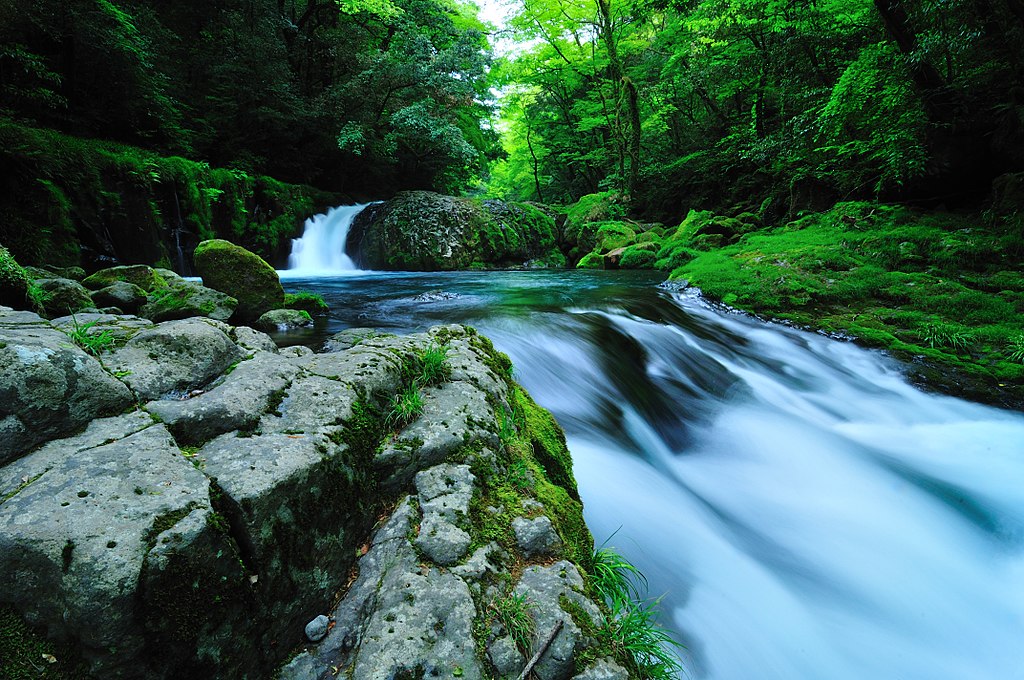Aug 30, 2022
Great Walks in Kumamoto Prefecture
Kumamoto has to be one of the best destinations in Japan for walks. The number of options available means you’ll never need to repeat the same walk — although you may discover some favorites you want to return to repeatedly. As a starting point, a few walks stand out as the best.
Shiramizu Falls
Waterfalls are always beautiful, but hiking out to them is often strenuous. Shiramizu Falls is much more accessible than many others. Reach the trail by driving 30 minutes from Takamori to the Hinatamenosato campsite — the walk is just 600 kilometers. It starts out flat and then takes you up a series of steps, but these are easy to climb. After passing a few small waterfalls, you’ll reach a volcanic rock cliff, down which the main falls cascade. The entire trail is under a canopy of maple trees, making this a perfect option for escaping the summer heat and seeing the autumn leaves in the fall.
Mount Kishima
The Aso caldera is made up of five mountains, one of which is Mount Kishima. You can reach its peak in just over an hour, but the walk is moderately difficult due to the elevation of 225 meters. Once you’ve reached the top, you’ll be rewarded with fantastic views of the surrounding landscape.
Kusasenri
A walk you definitely must not miss while you’re in Kumamoto is Kusasenri. This is a plateau created by two giant craters, still filled with magma but topped with ash from Mount Nakadake over thousands of years. The area is a grassland where horses and cattle graze, but lakes fill the craters after heavy rainfall. To hike Kusasenri, you can take the 4.2-kilometer loop trail that starts near Aso.
Mount Nakadake
You can also pay a visit to Mount Nakadake and Mount Takadake, the largest active volcano in the country. Be warned that this is quite a challenging hike. The trail is 9.3 kilometers long and may take 3.5 hours to complete.
Kumamoto Castle
Who said you need to leave the city for a walk in Kumamoto? The route around the castle is great for beginners, as it’s only around 2 kilometers and almost entirely flat, meaning it will take just around 30 minutes to complete. It’s a great opportunity to take in the history of Kumamoto while getting some exercise.
Suizenji Gardens
Close to downtown Kumamoto, you’ll find Suizenji Gardens. Walking around the grounds, you’ll find two shrines, a couple of bronze statues, tea rooms, and a lake. Twice a year, the gardens hold a yabusame ceremony (a mounted archery ritual), and performances occur throughout the spring and fall in the Noh theater. Since the park is a popular tourist destination, it’s best to visit on a weekday.
Ezu Lake
Kumamoto is known for its underground springs that provide high-quality water to the prefecture. Some of this water accumulates in Ezu Lake, which is right by Suizenji Gardens — you may like to visit both in the same day. As well as walking around the lake, you can swim (in the summer), rent fishing equipment, or go out on the water on a rowing boat or paddle boat.
Kikuchi Gorge
Head to Kikuchi Gorge in the Kikuchi Valley to incorporate forest bathing into your walk. You can choose between 30 and 60-minute hikes featuring moss-covered trees and waterfalls as you walk along the gorge.
Takachiho Gorge
Kikuchi isn’t your only option for a gorge in Kumamoto — there’s also Takachiho Gorge. From the Takachiho Bus Center, it’s a 30 to 40-minute walk to reach the gorge. Once there, you can walk along the paved path to see the deep gorge and waterfalls from above. Alternatively, combine your walk with a boat trip. If possible, go on a weekday to avoid the crowds.
Ama No Yasukawara Cave
Another spot in Takachiho is Ama No Iwako Shrine, which offers another great opportunity for a walk through the forest. Just 10 minutes from the shrine itself is Ama No Yasukawara Cave. The scenic walk takes you across an arched bridge and along the Iwato River. After rounding a corner, you’ll suddenly see the cave, which is an important place in Japanese mythology.
Yuka Family Road
An almost 30-kilometer trail, Yuka Family Road is built on old railway tracks, making it ideal for biking as well as hiking. If you make it all the way, you’ll reach Yamaga, which has some interesting sites, including shrines and onsen.
Aso Sankinkotai Road
Another road walk is Aso Sankinkotai Road, which dates back to the late 16th century. However, it is much shorter route, running from Akamizu village to the caldera wall and back. It takes around 40 minutes to reach the top and 30 minutes to descend (including time for some photos). You’ll be following in the tracks of the Kumamoto lords who used to walk here from Kumamoto Castle.
Sorafune Pier
Climb Mount Tangoyama to reach Sorafune Pier — a viewing platform over the caldera. From Aso Station, it’s a 15-minute drive to the parking lot, after which it’s a hike of about 30 minutes to reach the pier. If you don’t have your own mode of transport, it’s also possible to walk from Aso Station. Try to go on a clear day to take advantage of the chance for views.
Tatsuda Nature Park
Close to Kumamoto University is the hidden secret of Tatsuda Nature Park. There’s enough to keep you interested here for a whole day out — and you won’t find the crowds of tourists that are common in other spots. The gardens are covered with moss and shaded by bamboo. Just be aware that if you want to visit one of the two tea rooms, you’ll need to book in advance.
From short walks to intense hikes, Kumamoto has everything. Pick a different walk each week to explore all the natural beauty around the prefecture. You could start with the more leisurely walks and work your way up to the harder ones — you’ll soon find that you’re fitter than ever!


About the author